-
-
FeaturesคุณสมบัติPenyelesaianRecursosFiturCaracterísticas精选功能功能特點المزايا
-
Solutionsโซลูชั่นPenyelesaianSoluçõesSolusiSoluciones解决方案解決方案الحلول
-
IntegrationsการผสานรวมIntegrasiIntegraçõesIntegrationsIntegraciones集成整合服務دمج مع تطبيقات أخرى
-
Affiliate/Partnersพันธมิตร/พันธมิตรทรัพยากรAfiliasi/Rakan KongsiAfiliados/ParceirosAfiliasi/MitraAfiliados/Partners联盟/合作伙伴聯盟/合作夥伴شريك
-
ResourcesจองการสาธิตSumberRecursosSumber dayaRecursosالموارد資源中心
The 8 Most Essential Affiliate Marketing KPIs You Should Be Tracking in 2025
KPIs (Key Performance Indicators) can be crucial in your Affiliate Marketing journey. People familiar with KPIs understand their practical value. This is true when handling big tasks Like:
- Annual budgeting
- Forging partnerships,
- Making Strategic Decision
By not having affiliate marketing KPIs, businesses risk operating in the dark, with limited visibility into the performance and impact of their affiliate marketing initiatives. This can lead to missed opportunities, ineffective resource allocation, and the inability to maximize the potential of their affiliate partnerships.
Don’t worry, you won’t face such things if you measure the following 8 KPIs that we have mentioned in the blog.

What are Key Performance Indicators (KPIs)?
KPIs are measurable values. They show how well a specific activity or campaign is doing. In affiliate marketing, KPIs help you assess campaign performance. They track the effectiveness of your marketing and guide your strategy.
In general, KPIs offer real-time insights into every area of the company’s operations. This transparency makes it easier for each department to manage its performance effectively.

Also, managers can make better strategies to address challenges. They can use them to make progress towards the company’s goals. Advanced affiliate tracking software provides comprehensive reports on specific tasks.
By monitoring KPIs, you can identify areas of improvement and make informed decisions to maximize your affiliate marketing ROI.
In affiliate marketing, Key Performance Indicators (KPIs) serve several crucial purposes. Let’s have a look at them one by one.
- KPIs Measure Success: They allow affiliate marketers to measure their marketing efforts. These efforts include website traffic, lead generation, and conversion rates. This helps in evaluating the effectiveness of different marketing strategies and campaigns.
- Setting and Monitoring Goals: KPIs help set clear, doable goals for affiliate marketers. They also offer a way to track progress toward these goals. Whether it is a target for sales, click-through rates, or customer acquisition, KPIs provide a clear benchmark for success.
- Optimizing ROI Requires Tracking KPIs: They show which channels, campaigns, or products bring in the most money. Marketers can then focus on getting more from these activities.
- Assessing Traffic and Leads: KPIs help assess traffic and lead from affiliate marketing. They help tell apart good and bad traffic sources. This helps marketers make adjustments.
- Partnership Evaluation: For merchants managing affiliate programs, KPIs help to assess affiliates’ performance. They also help to assess the success of the program. KPIs aid in allocating resources and developing effective partner relationships.
- KPIs Provide Valuable Insights: They let affiliate marketers make data-driven decisions. They use them to refine their strategies and allocate resources well. This leads to the best possible results.
Several types of Key Performance Indicators (KPIs) are common in many industries. They are also used in affiliate marketing. Here are the main types of KPIs:
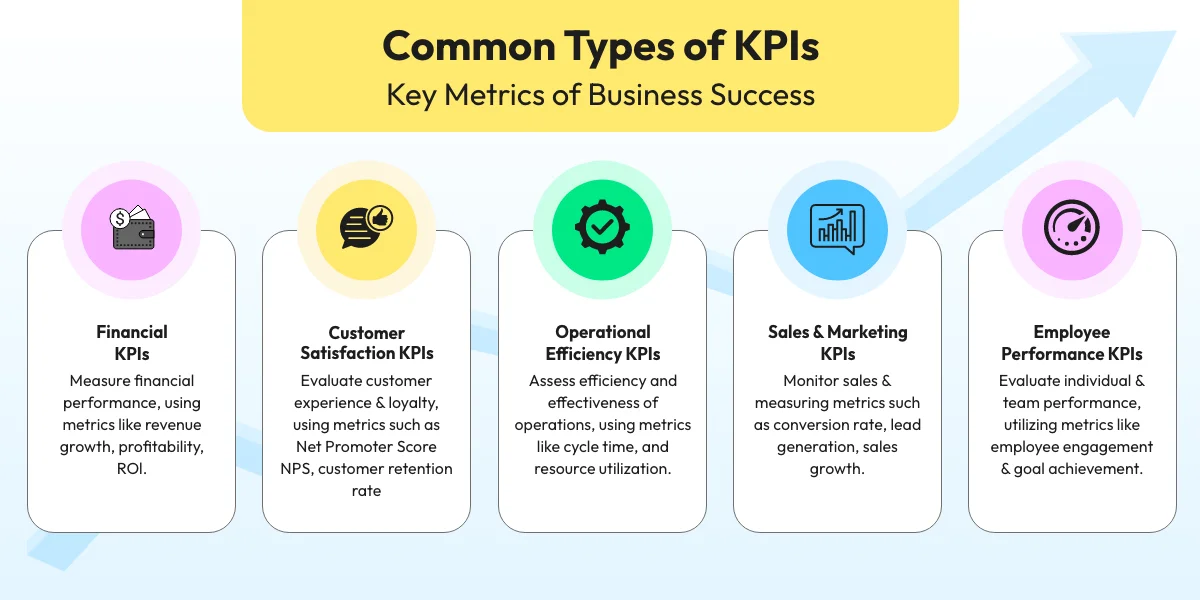
| Financial KPIs | These KPIs focus on the financial performance of a business. Examples include revenue growth rate. They also include gross profit margin, Return On Investment (ROI), and customer lifetime value. |
| Marketing KPIs | These KPIs measure the effectiveness of marketing efforts. These include website traffic, conversion rates, and click-through rates. Also, Cost Per Acquisition (CPA) and Return On Ad Spend (ROAS). |
| Operational KPIs | These KPIs assess the operational efficiency and productivity of a business. Examples include order fulfilment cycle time, customer support resolution time, and website uptime. |
| Customer KPIs | These KPIs center on customer-related metrics. For example, there is the customer retention rate. There are also the Customer Satisfaction Score (CSAT) and the Net Promoter Score (NPS). |
| Sales KPIs | These KPIs track the performance of sales activities. Examples include sales growth. Also, average order value, sales conversion rate, and lead-to-customer conversion rate. |
| Productivity KPIs | These KPIs measure the productivity and efficiency of business operations. Examples include employee productivity, marketing campaign efficiency, and affiliate program management efficiency |
Each KPI type provides insights into a different aspect of business performance. When used together, they give a full understanding of the health and success of an affiliate marketing program.

Importance of Tracking KPIs in Affiliate Marketing
Tracking affiliate marketing KPI is essential for marketers for several reasons. Firstly, it allows you to measure the effectiveness of your campaigns and determine which strategies are driving results. By identifying the best-performing campaigns, you can allocate your resources more efficiently and focus on what works.

Tracking affiliate marketing KPIs is crucial in affiliate marketing for several reasons:
- Performance Evaluation: Tracking KPIs helps affiliate marketers evaluate their marketing. It lets them understand what is working and what needs improvement.
- Return on Investment(ROI): Affiliate Marketing KPIs help measure return on investment (ROI) for marketing campaigns. They let marketers optimize spending and focus on the best channels.
- Tracking Statistics: These include click-through rates, conversion rates, and average order value. They use this data to optimize their strategies. The goal is to improve conversion and maximize revenue.
- Identifying Top Performers: Tracking KPIs helps find the top affiliates. It lets marketers allocate resources well and build strong partnerships with them.
- Budget Allocation: KPIs show which marketing channels and affiliates drive the most value. They enable better budget allocation for maximum impact.
- Redefining Choices: KPI data helps affiliate marketers make informed strategic choices. They can adjust commissions, refine targeting, or diversify tactics.
- Performance Benchmarking: KPI tracking enables comparing performance over time. It lets marketers set and track progress towards realistic goals.
The 8 Most Essential Affiliate Marketing KPIs for 2025
- Conversion Rate
In affiliate marketing KPI, the conversion rate is the percentage of website visitors who complete a desired action. This action is usually making a purchase, signing up for a service, or filling out a form. They do this after clicking on an affiliate’s link.
The formula for Conversion Rate in affiliate marketing is:
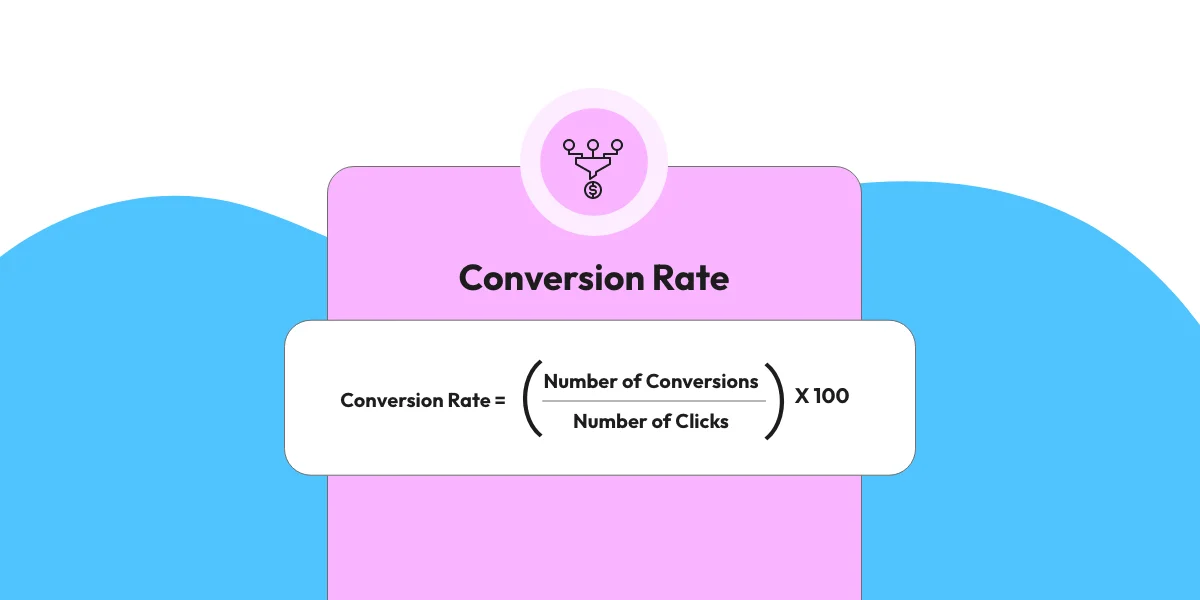
The conversion rate is critical. It measures how well an affiliate’s marketing drives actions from their audience to the merchant’s site. A higher conversion rate shows that more of the affiliate’s audience is taking the desired action. This leads to more revenue and success for both the affiliate and the merchant.
Understanding the conversion rate is key for affiliates. It directly affects their earnings. They can do this by analyzing and improving different parts. These include the quality of traffic, also the relevance of the promoted products or services, and the effectiveness of the call-to-action. Finally, the user experience of the merchant’s site.
Focusing on these key aspects can help affiliates earn more. It can also help them bond with merchants. Also, a high conversion rate benefits merchants, it does this by driving more sales and leads. So, it is a goal that helps both parties in the affiliate marketing ecosystem.
- Average Order Value (AOV)
In affiliate marketing, the Average Order Value (AOV) is the average money spent by customers. They spend it when they purchase through an affiliate’s referral link. It is calculated by dividing the total revenue from all orders by the number of orders within a specific period.
The formula for Average Order Value in affiliate marketing is:
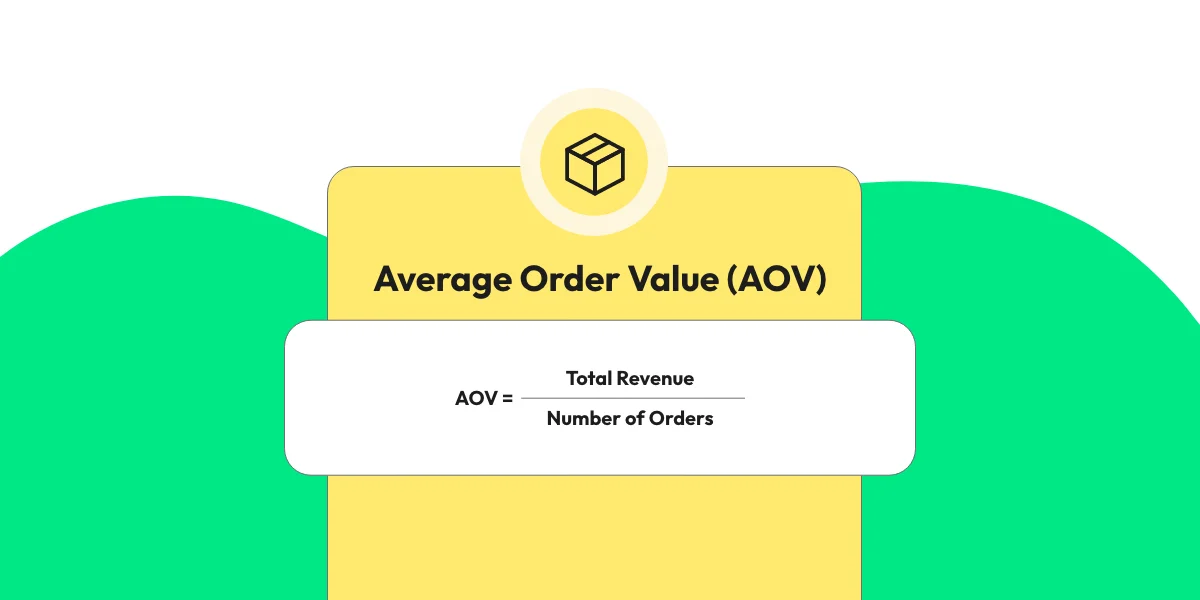
AOV is a crucial metric as it provides insights into the purchasing behaviour of customers who are referred by affiliates. A higher AOV shows that customers spend more per transaction. This can directly affect affiliates’ earnings and the program’s profit.
Affiliates who understand the AOV can optimize their strategies. They do this by focusing on products or services with higher AOV. This allows them to maximize their potential earnings.
For merchants, AOV helps in evaluating affiliate performance. It measures the average value of sales from affiliate marketing efforts.
- Click-Through Rate (CTR)
Click Through Rate (CTR) is a metric which measures clicks on an affiliate’s link or ad, relative to the times the link was viewed. The rate is found by dividing clicks on the affiliate’s link by the times the link was displayed. Then, the result is multiplied by 100 to make it a percentage.
The formula for Click Through Rate in affiliate marketing is:
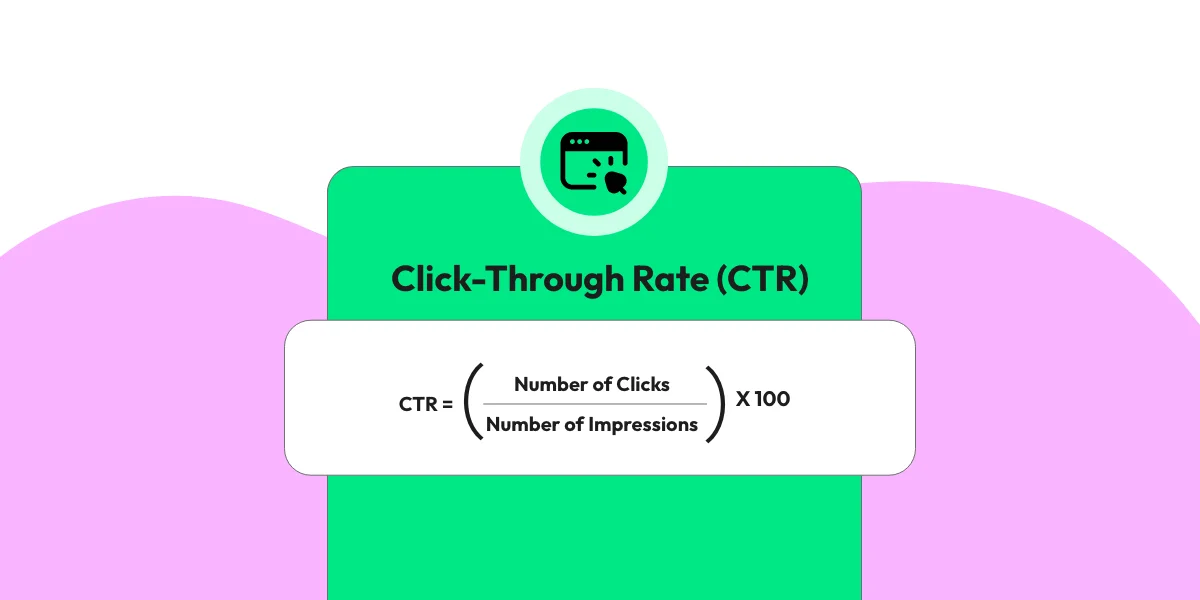
Where:
- Number of Clicks: The total number of clicks on an affiliate’s promotional link or ad.
- Number of Impressions: The total number of times the affiliate’s link or ad was displayed to users.
The result is a percentage. It shows the proportion of users who clicked on the affiliate’s link out of the total who viewed it.
CTR is important. It shows how well an affiliate’s promotions work. A higher CTR shows that more of the audience who saw the affiliate’s link took the desired action, they clicked on the link.
For affiliates, watching and improving CTR is crucial. It can directly affect their earnings. Affiliates can analyze and improve ad placement, messaging, and targeting. This will increase their CTR and drive more traffic to the merchant’s site, it may also raise the chance of making sales or leads.
- Return on Investment (ROI)
Return on Investment (ROI) in affiliate marketing KPI which measures profitability. It compares it to the cost of the campaign. It’s a key metric, and it is used to judge the effectiveness and success of an affiliate marketing initiative.
In affiliate marketing, the ROI is calculated by comparing revenue to costs. Costs include affiliate commissions, advertising expenses, and other costs.
The formula for calculating ROI in affiliate marketing is:
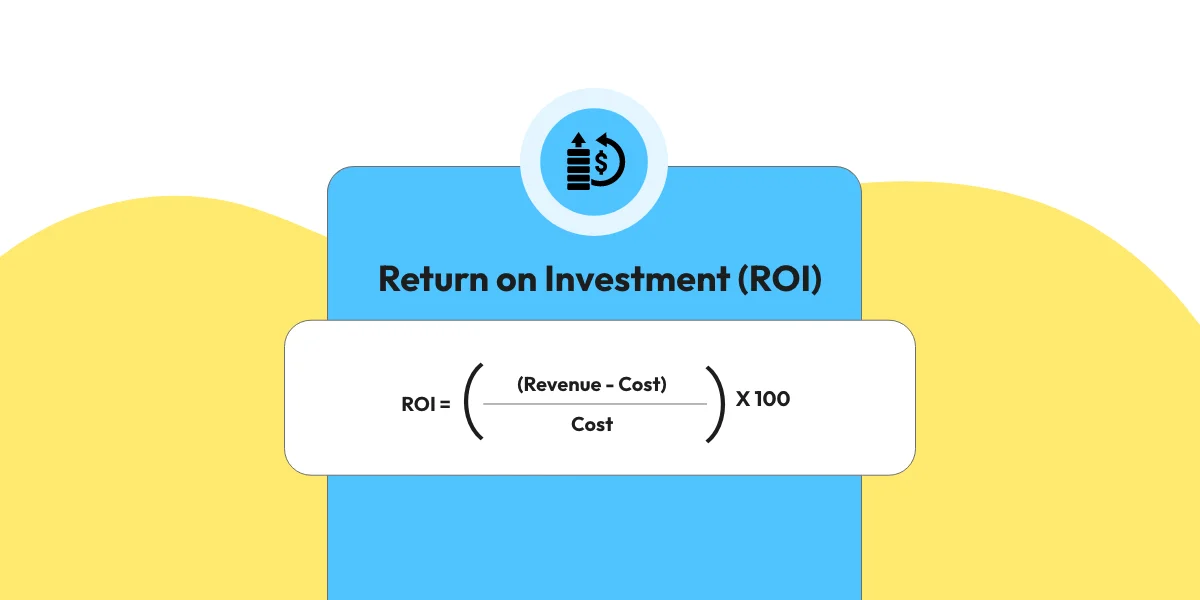
Where:
- Revenue represents the total income generated from the affiliate marketing campaign.
- Cost includes all campaign expenses. These include affiliate payouts, ad costs, and other relevant spending.
A positive ROI means the affiliate marketing campaign made more revenue than costs, making it profitable. A negative ROI means the campaign did not make enough money, leading to a loss.
Understanding and improving ROI is crucial. It’s crucial for both affiliates and merchants in affiliate marketing. Affiliates aim to maximize their ROI, they do this by promoting high-commission products or services that drive big revenue.
They do this by using good promotions, they target the right audience, they improve their campaigns to make them more profitable.
- Customer Lifetime Value (CLV)
In affiliate marketing, Customer Lifetime Value (CLV or LTV) is the expected future profit from a customer. It takes into account their purchases and engagement over time.
We calculate CLV by estimating the total revenue a customer will generate over their whole relationship with a business. We subtract the costs of getting and serving that customer.
The formula for calculating CLV is:
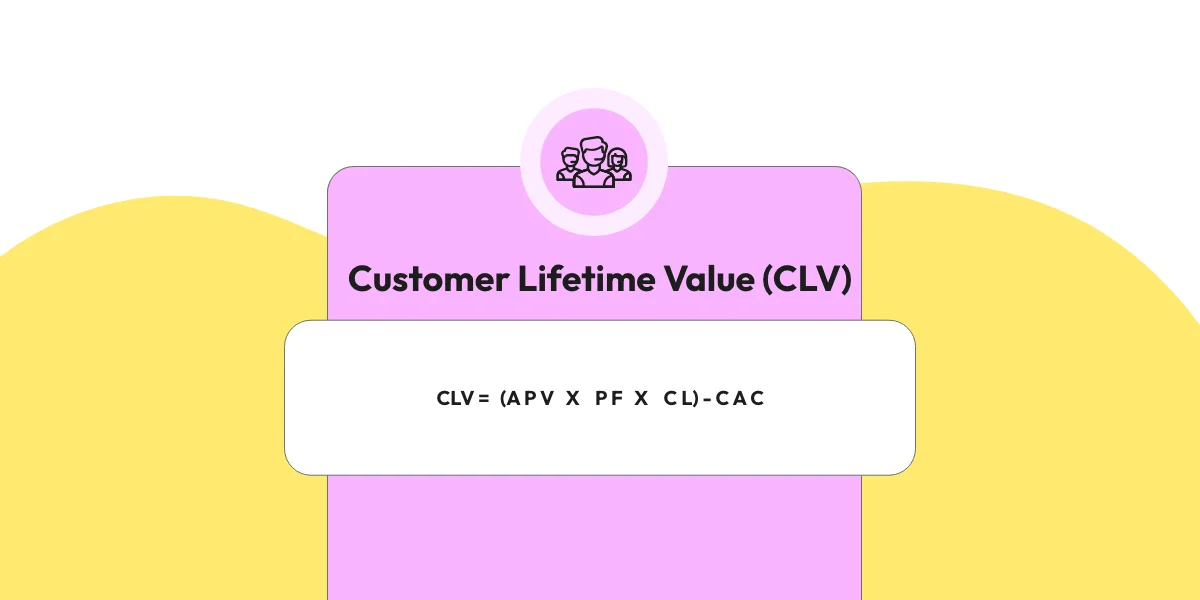
Where:
- Average Purchase Value (APV) is the average amount a customer spends per purchase.
- Purchase Frequency (PF) is the average number of purchases a customer makes in a time frame.
- Customer Lifespan (CL) is the predicted duration of the customer’s relationship with the business.
- Customer Acquisition Cost (CAC) includes all expenses. They are for acquiring a customer, such as marketing and advertising costs.
Affiliates and merchants in affiliate marketing must understand CLV. It’s essential for several reasons. For affiliates, focusing on driving high CLV customers can lead to increased commission earnings over time. High CLV customers are more valuable to the affiliate’s promotions.
- Cost per Acquisition (CPA)
Cost per Acquisition (CPA) in affiliate marketing refers to the total cost to get a customer through an affiliate campaign. CPA is a key measure, and it shows how well an affiliate marketing program gets new customers.
The CPA is the total campaign cost divided by the number of customers acquired.
The formula for calculating CPA is:
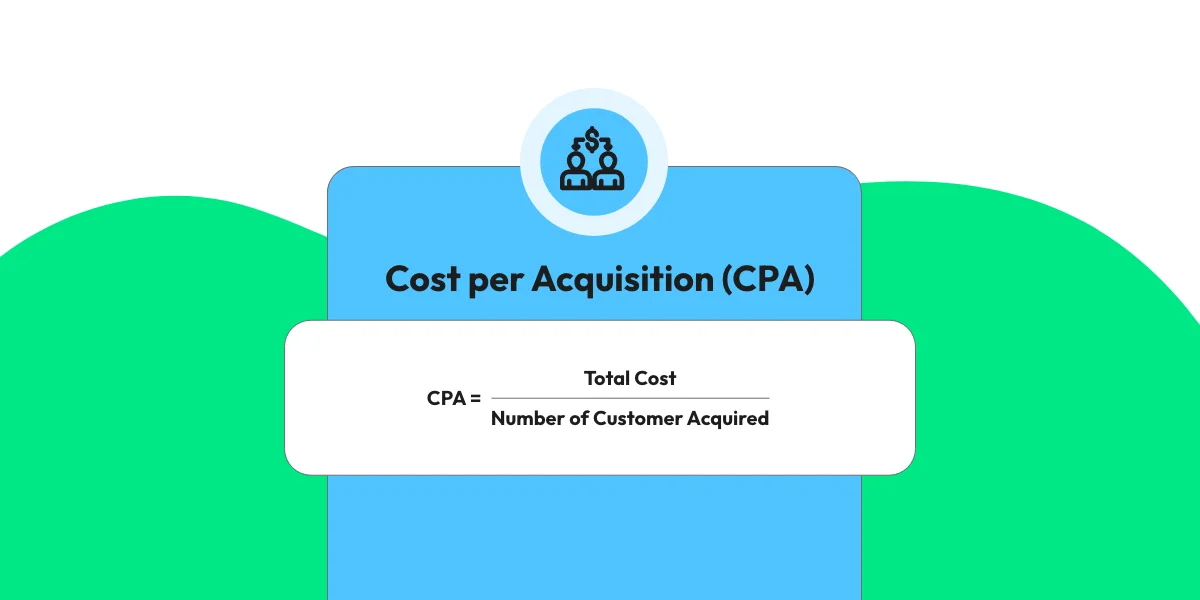
Where:
- Total Cost includes all expenses from the affiliate marketing campaign. It covers affiliate commissions, advertising costs, and other relevant spending.
- Number of Customers Acquired is the total number of new customers gained. They are gained as a result of the campaign.
Both affiliates and merchants in affiliate marketing must understand and optimize CPA. It is essential for them. For affiliates, a lower CPA means cheaper customer acquisition, and thus lead to higher earnings.
By optimizing their promotions and targeting the right audience, affiliates can reduce their CPA. This will improve the profitability of their affiliate marketing efforts.
- Revenue per Click (RPC)
Revenue per Click (RPC) in affiliate marketing KPI, which calculates the average revenue for each click on an affiliate’s link or ad. RPC is a key performance indicator, and it shows how well an affiliate’s promotions generate revenue.
To calculate Revenue per Click, use the following formula:
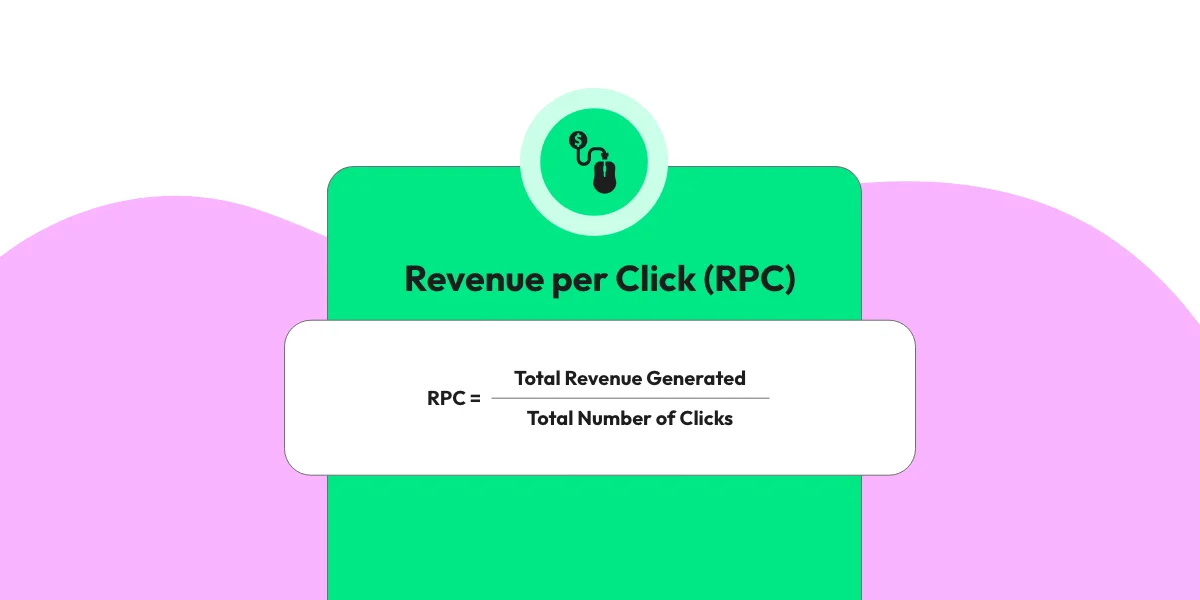
Where:
- Total Revenue Generated represents the overall income generated from the affiliate marketing campaign.
- Total Number of Clicks is the total number of clicks on the affiliate’s links or ads.
Affiliates must understand RPC. It helps them gauge their content’s effectiveness and the value of the traffic they drive to the merchant’s site.
Tracking RPC helps affiliates. It shows which channels, products, or strategies bring the most revenue for each click. It lets them improve their efforts and focus on driving the traffic most likely to earn the merchant money.
- Earnings per Click (EPC)
Earnings per Click (EPC) in affiliate marketing KPI, which calculates the average earnings for each click on an affiliate’s link or ad. EPC is a key indicator, and it is used to evaluate the performance and profitability of an affiliate marketing campaign.
EPC is calculated using the following formula:
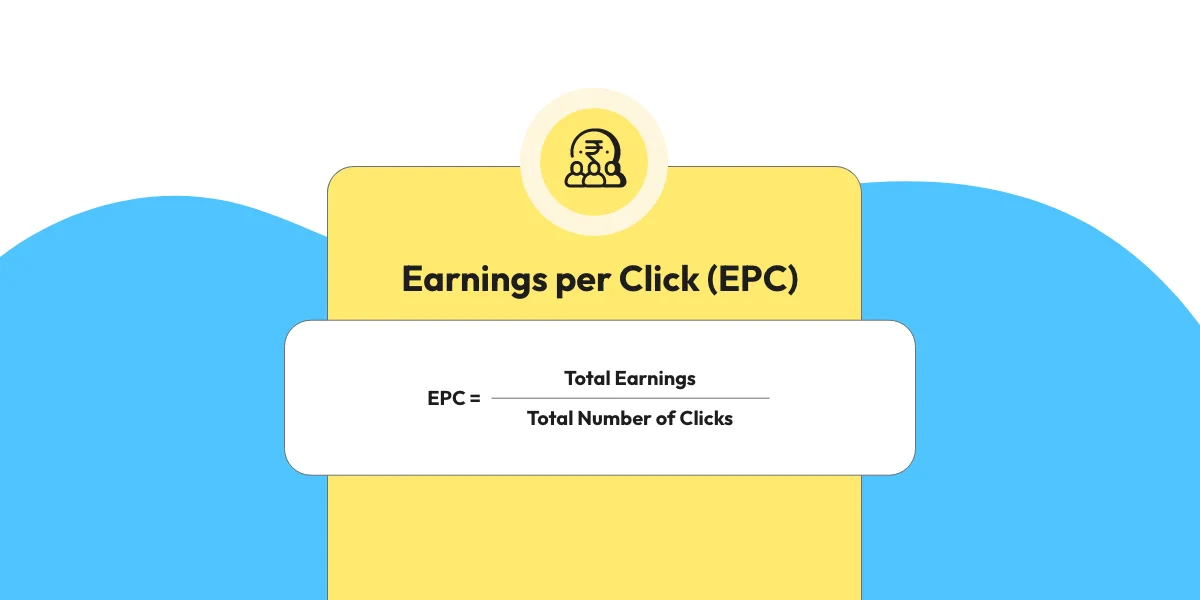
Where:
- Total Earnings represent the total income. They are from commissions in the affiliate marketing campaign.
- Total Number of Clicks denotes the total number of clicks on the affiliate’s promotional links or ads.
EPC is a crucial metric for both affiliates and merchants. Affiliates use it to see how well promotions work. They also learn the value of the traffic they drive to the merchant’s site.
Tracking EPC helps affiliates find the best ways to make money. They can see which channels, products, or strategies yield the most profit per click. This lets them improve their promotions and focus on driving high-converting traffic.

Importance of Affiliate Network Performance
In affiliate marketing, affiliate network performance is how well a network helps with marketing. It looks at how well it manages the activities.
It includes key performance indicators (KPIs) and metrics. They assess the overall performance, impact, and success of the affiliate network. This network connects merchants with affiliates and drives revenue through affiliate marketing.
Key Aspects of Affiliate Network Performance:
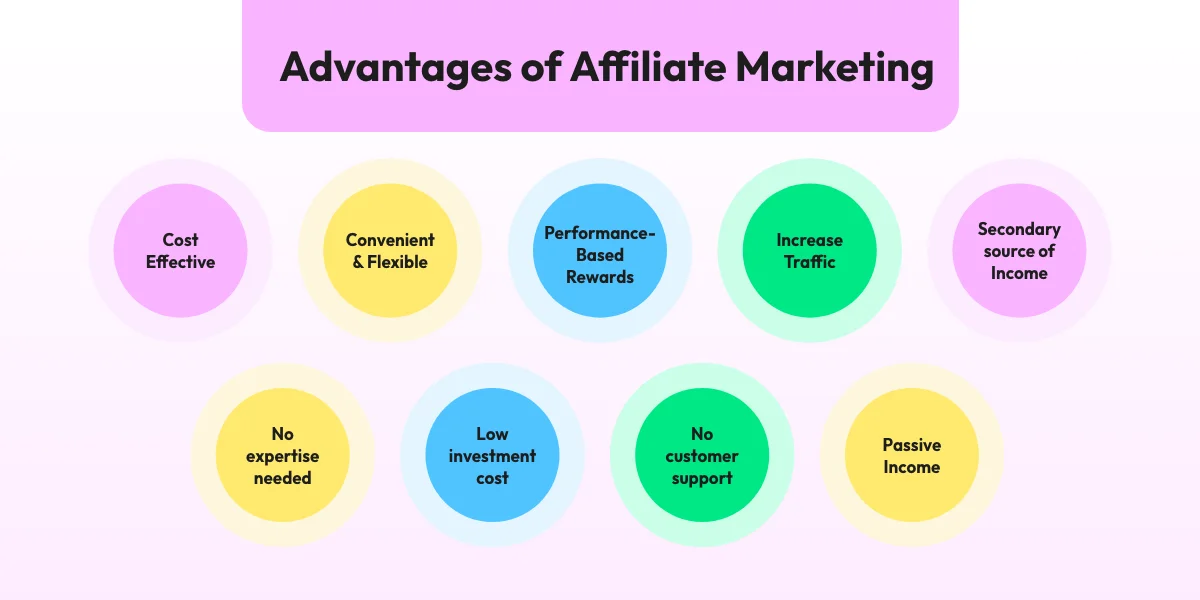
| Affiliate Recruitment and Management | This involves two things. First, you evaluate the affiliate network’s ability to attract and engage high-quality affiliates. Second, you manage and support their activities well to enhance performance. |
| Merchant Relationship Management | Can the affiliate network keep strong relationships with merchants? Can they give them valuable insights? Can they help merchants and affiliates collaborate well? |
| Tracking and Reporting | We examine the accuracy and reliability of the tracking tools. These are provided by the affiliate network. We also look at the reliability of the network’s reporting tools. They are key for monitoring performance. They attribute conversions and ensure transparency in affiliate activities. |
| Payment Processing and Timeliness: | We rate how fast the affiliate network pays affiliates. They must be accurate and on time. This is crucial for keeping affiliates’ trust and satisfaction. |
| Compliance and Fraud Prevention | We will assess the affiliate network’s measures. They ensure it follows industry regulations. We will also look at its ability to find and stop fraud. Fraud could harm the honesty of affiliate marketing campaigns. |
| Technical Support and Resources | Technical support and resources are important. They help affiliates and merchants perform better and understand the affiliate marketing system. We will gauge the level of support, resources, and training provided. |
Importance of Monitoring Affiliate Network Performance:
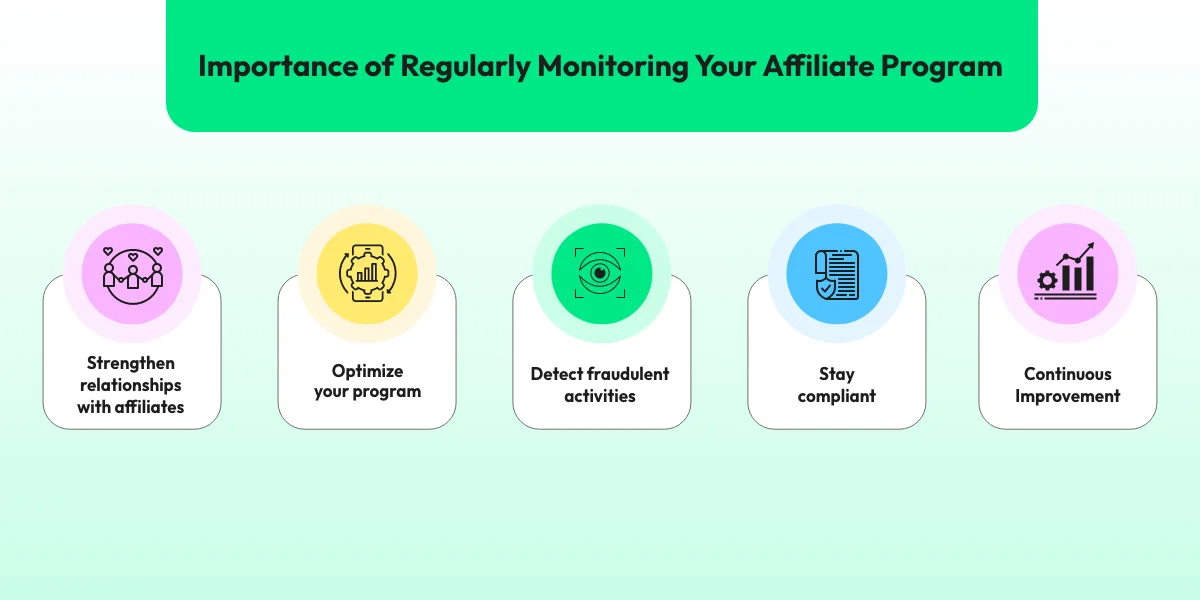
- Optimizing Campaign Effectiveness: Tracking affiliate marketing KPI helps merchants and affiliate managers. They can find areas to improve, refine strategies and make affiliate marketing campaigns more effective.
- Enhancing Partner Relationships: Understanding the affiliate network’s performance helps partners communicate and collaborate. It leads to stronger partnerships and better results.
- Maximizing Return on Investment (ROI): By assessing the affiliate network, stakeholders can use its performance data to make better decisions. This will maximize their affiliate marketing’s ROI and allocate resources better.
Affiliate network performance in affiliate marketing involves evaluating many factors. These factors relate to the network’s functionality, efficiency, and impact. They are concerned about its role in connecting merchants and affiliates. It drives revenue and upholds the integrity of affiliate marketing.
Watching and improving affiliate network performance is crucial. It is key to success in affiliate marketing, and it fosters good relationships between merchants and affiliates.
How to Track and Analyze Affiliate Marketing KPIs
You must track and analyze affiliate marketing KPIs. They are crucial for optimizing your campaigns and making the most revenue. Here’s how to do it effectively:

- Define Your KPIs: Start by identifying the key metrics that align with your affiliate marketing goals. Common KPIs include conversion rate and click-through rate. They also include revenue per click, average order value, and return on investment (ROI).
- Use Tracking Tools: Use affiliate tracking software or platforms. They track your links and campaigns. These tools provide insights into clicks, conversions, and other relevant data in real time.
- Monitor Traffic Sources: Track where your traffic comes from. This will help you find which channels drive the most engagement and conversions. This allows you to allocate resources effectively and focus on high-performing channels.
- Analyze Conversion Data: Study Conversion Data. Dive deep to see which products or offers are making the most money. Identify trends and patterns to optimize your promotional strategies accordingly.
- Evaluate Affiliate Partners: Assess their performance based on their contribution to your KPIs. Identify top-performing affiliates and nurture those relationships for continued success.
- Calculate ROI: Measure the return on investment for your affiliate marketing. Do this by comparing the revenue generated to the costs incurred. This helps determine the profitability of your campaigns and informs future investment decisions.
- Optimize Campaigns: Measure the return on investment for your affiliate marketing. Do this by comparing the revenue generated to the costs incurred. This helps determine the profitability of your campaigns and informs future investment decisions.
- Test and Experiment: Continuously test different strategies, ads, and offers. This will help you find what resonates best with your audience. Experimentation allows you to refine your approach and uncover new growth opportunities.
- Regular Reporting: Create regular reports to track your affiliate marketing KPIs over time. This allows you to measure progress. It helps you find areas for improvement.
Continuously monitor and analyze your affiliate marketing KPIs. They provide valuable insights. These insights are crucial. They help you make informed decisions and achieve success in affiliate marketing.
You can track metrics like conversion rate, click-through rate, revenue per click, and ROI. Doing so lets you spot trends, judge performance, and improve your strategies. These insights let you allocate resources well. They also help you find areas to improve and seize growth opportunities.
Data guides you. It helps you refine your campaigns and build stronger affiliate partnerships. This improves the overall performance and profit of your affiliate marketing.
Conclusion:
Success in affiliate marketing depends on tracking and analyzing key performance indicators. The field is always changing. However, in 2025, the 8 most important affiliate marketing KPIs are Conversion Rate, Average Order Value, Click-Through Rate, Return on Investment, Customer Lifetime Value, Cost per Acquisition, Revenue per Click, and Earnings per Click.
Affiliate Network Performance can show you how well your campaigns work. You can use it to improve your strategies and boost your ROI. Remember to utilize the right tools and software to streamline your tracking and analysis processes. Take your affiliate marketing to new heights by unlocking the power of KPI tracking in 2025.
Frequently Asked Questions
- What are Key Performance Indicators (KPIs) in Affiliate Marketing?
KPIs in affiliate marketing are measurable values. They show the success of specific activities or campaigns.
- Why are KPIs important in affiliate marketing?
KPIs are vital in affiliate marketing. They allow marketers to measure success. Marketers can set and track goals. They can improve ROI and check traffic quality. They can assess partnerships and make data-driven choices.
- What types of KPIs are commonly used in affiliate marketing?
Common KPIs in affiliate marketing include financial ones, like revenue growth and ROI. Others are operational, like order fulfilment time, and customer, like retention rate. Furthermore, there are sales and productivity KPIs, including conversion rate and campaign efficiency.
- How do I track and analyze affiliate marketing KPIs effectively?
To track and analyze affiliate marketing KPIs well, define your KPIs. Use tracking tools, monitor traffic sources, analyze conversion data, evaluate affiliate partners, calculate ROI. Optimize campaigns. Test and experiment. Create regular reports.
- What are the benefits of monitoring affiliate network performance?
Monitoring affiliate network performance helps optimize campaign effectiveness. Furthermore, it also enhances partner relationships, thereby maximizing ROI. It helps identify growth opportunities and show the impact of affiliate marketing efforts.
- How can I start tracking my affiliate marketing KPIs?
You can track your affiliate marketing KPIs by finding relevant metrics. Use tracking software analyze data often. Improve campaigns based on insights.
Latest Comments